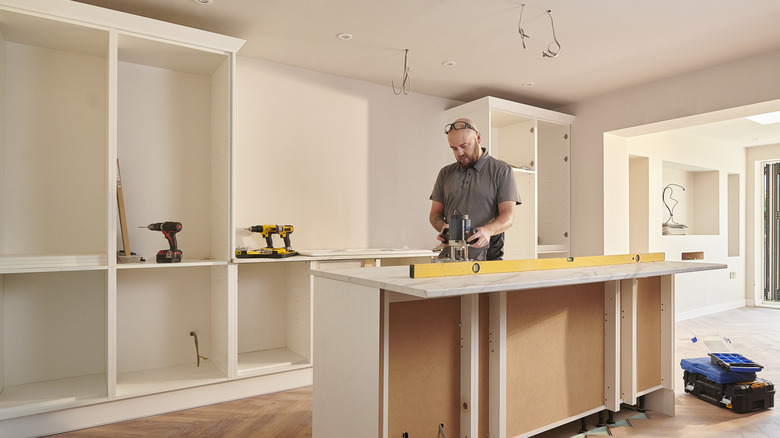HGTV's Nate Berkus Says These Home Upgrades Are Definitely Worth The Splurge
Home upgrades are seldom an affordable endeavor. Research from Houzz reports that the median spend for home renovations has increased significantly in recent years. Still, most homeowners take the extra time to scout deals and discounts and mount DIY projects to keep costs down as much as possible. But, to avoid a renovation disaster, it's important to know when spending a little more is necessary and when it's worthwhile to look for deals. There's no better place to go for home upgrade advice than experienced and renowned designer Nate Berkus, one-half of the design duo on HGTV's "The Nate and Jeremiah Home Project."
While some designers focus solely on luxury and others only on pinching pennies, Berkus is known for his expertise with family homes, making design approachable, and finding the right balance between splurging and saving to create a home that reflects the owner's story and personality. On HGTV projects, in interviews, and on his social media, the designer frequently shares tips about where to spend and where to save.
Berkus makes distinguishing between the two a breeze with one easy tip. "Don't skimp on anything built-in like the countertops, appliances, plumbing," he shared in an interview with MyDomaine. "Rugs and pillows are a great place to go for a deal, as are lighting options and accessories." Let's break down how to use the HGTV star's tried and tested advice to pull off a successful renovation and prioritize spending where it counts.
Budget for the big things
A successful renovation doesn't just look good, it's built to last. That's why HGTV's Nate Berkus won't compromise on elements that get used every day, like countertops, appliances, and plumbing. When you're planning your investments, it's important to know which spaces are worth spending more on first. Data from Houzz shows that kitchens and primary bathrooms incur the highest spend. This makes sense as renovating these rooms often includes overhauls of built-ins like cabinets, islands, sinks, and showers. Knowing this will help you budget more for these expenses and move away from splurging on rooms with fewer built-ins, like bedrooms, where you can usually decorate on a budget.
A crucial part of ensuring your built-in elements are set up successfully is ensuring this part of your renovation is completed by professionals whose work you can trust. Berkus doesn't think this is the place for guesswork or going DIY, and he recommends working with licensed contractors with known references to avoid an upgrade failure. "Don't go for the cheapest, don't experiment, you need to have references and use those references," he advised on Facebook.
While decorative elements can be easily replaced, fixing a major mistake and replumbing a home requires $7,500 on average, and $15,000 on the higher end according to Angie's List. Built-in elements like these aren't solely aesthetic but are required for daily life tasks. Because they're built-in, they're costly to install and even more expensive to fix.
Save on the small things
Nate Berkus also detailed where homeowners can save on their renovations. The HGTV star is known for rooms that feel layered, interesting, and assembled over time by incorporating decorative elements that are thrifted, vintage, and used. The designer's home collection contains many expensive decor pieces, but if you're planning large-scale renovations and need to budget for spending more on built-in elements, take his advice and opt for used decor.
The designer looks to sites like Etsy, eBay, and Chairish to find vintage pieces. Sourcing items like this antique brass lamp under $20 is an easy way to renovate while adding character to your space on a budget. Savvy shoppers shouldn't limit themselves to online stores either as flea market finds and estate sales are great places to find deals and negotiate on prices.
Thrifting home decor items like pillows, rugs, and light fixtures, and buying second-hand furniture are often much cheaper than buying new. It also adds the storied, layered look that Berkus loves and gives the impression that the room has been assembled over time. Since spending is inevitable, splashing out on the built-ins and saving on the smaller stuff is a great rule of thumb for a successful home upgrade. Plus, this leaves the professionals to handle the bigger projects so you can have fun designing.



